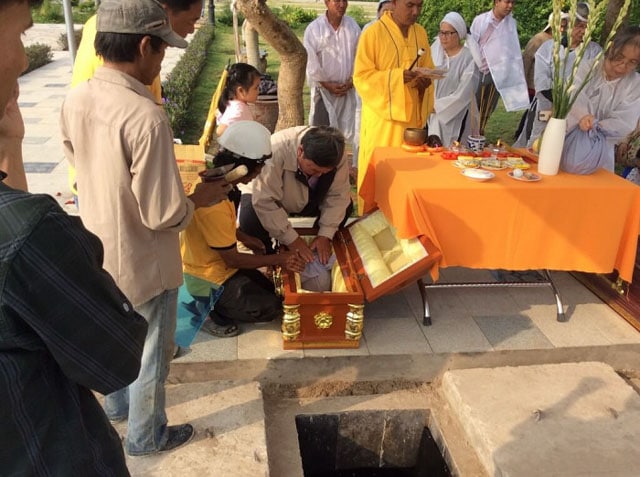Trong cuộc đời con người, khi còn sống có những dấu mốc quan trọng, thì khi đã khuất núi cũng còn rất nhiều ngày quan trọng khác mà con cháu, những người còn sống cần nhớ, thực hiện theo đúng tập tục cũng như giúp cho người đã khuất nhanh chóng được an lòng, siêu thoát. Những ngày quan trọng của người đã khuất sẽ được chúng tôi ghi lại và tổng hợp ở bài viết này.
Văn khấn lau dọn bàn thờ những điều kiêng kị khi lau bàn thờ 2021
Giới thiệu dự án nghĩa trang Lạc Hồng Viên Hòa Bình
Nội dung bài viết
Lễ phát dẫn (lễ đưa tang)

Lễ phát dẫn được thực hiện trong ngày đưa người đã khuất về nơi an nghỉ cuối cùng. Lễ phát dẫn diễn ra tại gia, con trai trưởng của người đã khuất sẽ chống gậy đi đầu (gậy vót tròn đầu nếu tang cha, vót vuông nếu tang mẹ), lần lượt các con trai gái đi theo sau. Cạnh quan có hai vị thần phương tướng làm bằng giấy đặt hai bên, dáng vẻ giữ tợn để đuổi ma quỷ.
Theo trong lễ phát dẫn có thêm sư thầy Phật giáo để tụng kinh đưa hương hồn người đã khuất về nơi an nghỉ. Lễ phát dẫn diễn ra long trọng, cẩn thận và chỉnh chu.
Lễ an táng (lễ hạ huyệt)

Lễ an táng thường được xem thầy và chọn giờ hoàng đạo nhất có thể. Trước khi tiến hành lễ an táng phải cúng Thổ thần tại nơi sẽ hạ huyệt, để người mất được nhận nơi đây là ngôi nhà cuối cùng. Đồ cúng trong lễ an táng gồm có: trầu cau, rượu, đĩa xôi, vàng hương, thủ lợn hoặc chân giò. Các con cháu sẽ lần lượt đi quanh huyệt mộ bốc những nắm đất nhỏ và thả xuống.
Tiến hành hạ quan theo đúng giờ hoàng đạo chọn trước, tiến hành lấp đất, đắp nấm mồ. Sau khi xong lễ an táng thì mọi người về nhà. Từ sau hôm đó, chủ nhà thắp hương cơm canh cho người đã khuất đến hết 100 ngày.
Lễ 3 ngày (lễ tế ngu)
Sau 3 ngày chôn cất, con cháu trong nhà sẽ tiến hành lễ tế ngu. Đây là ngày quan trọng của người đã khuất để con cháu ra mộ, sửa sang lại phần mộ sao cho đẹp hơn, chỗ nào hôm trước đắp còn thiếu, bị sụt lún thì tiến hành đắp thêm đất cho tròn. Trong quá trình thực hiện đắp đất cho mộ thì không trèo lên trên để tránh sập ván quan ở dưới. Khi thực hiện lễ tế ngu bắt buộc phải có con trai trưởng, cháu đích tôn tới để thực hiện nghi thức cúng và động thổ.
Lễ 49 ngày (lễ chung thất)

Lễ Chung thất là lễ được thực hiện sau khi người đã khuất đủ 49 ngày. Lễ 49 ngày được tổ chức to, long trọng, có đầy đủ các loại đồ cúng thịnh soạn. Đây là lễ được thực hiện theo quan niệm của Phật giáo. Sau khi người mất, vong hồn sẽ rời khỏi thể xác, trải qua 7 lần phán xét trước khi xuống tới địa phủ. Mỗi lần phán xét sẽ kéo dài trong vòng 7 ngày. Sau khi phán xét xong, người mất có thể sẽ được đưa đi siêu thoát, giam vào địa ngục, nương nhờ vào cõi Phật.
Lễ 100 ngày (lễ tốt khốc)
Sau đúng 100 ngày sẽ tiến hành lễ Tốt khốc, đây là một trong những ngày quan trọng của người đã khuất, lễ tốt khốc con cháu sẽ thôi khóc than cho người đã khuất. Lễ Tốt khốc sẽ thực hiện cúng bái tại nhà, tại mộ với các đồ cúng được chuẩn bị đầy đủ từ trước, mở cỗ bàn mời họ hàng tới dự. Sau lễ 100 ngày, gia đình sẽ lấy ngày chết làm ngày giỗ hàng năm.
Giỗ đầu (tiểu tường)
Sau một năm khi người thân khuất núi, gia đình sẽ tổ chức giỗ đầu. Giỗ đầu thường trang nghiêm, có sự hội ngộ của hầu hết con cháu trong nhà của người đã khuất. Giỗ đầu được thực hiện với các lễ cúng, mời đầy đủ họ hàng thân thuộc tới dự.
Giỗ hết (đại tường)

Giỗ hết tùy theo từng vùng sẽ có cách tổ chức khác nhau, thường cách giỗ đầu khoảng 2 – 3 năm. Giỗ hết cũng to không kém giỗ đầu, báo hiện người đã mất thực sự an nghỉ, sau giỗ hết mỗi năm gia đình sẽ làm giỗ cho người đã khuất định kỳ, để con cháu ai có thời gian thì về, cùng nhớ về người quá cố.
Giỗ hàng năm tiếp tục được thực hiện đầy đủ, duy trì đều đặn từng năm cho đủ 5 đời. Theo quan niệm và tập tục, sau 5 đời, vong linh người chết sẽ được siêu thoát, đầu thai kiếp khác nên con cháu không cần làm giỗ nữa.
Cải táng (bốc mộ, sang cát, lên nhà mới)
Cải táng là tập tụng bốc mộ, đào huyệt lên để đưa người đã khuất tới “ngôi nhà mới” sạch sẽ hơn, hoặc là tập tục bốc mộ quy tập gia tộc. Thường thì lễ cải táng sẽ tiến hành sau khoảng 4 – 7 năm để xương cốt đã hoàn toàn sạch sẽ, không còn thịt. Lễ cải táng cũng được diễn ra khá long trọng, có sự góp mặt đầy đủ của các thành viên trong gia đình, dòng tộc.
Lễ bốc mộ sẽ được chuẩn bị cẩn trọng từ 1 – 3 tháng, thường bốc mộ sẽ tiến hành vào mùa khô, vào cuối năm thời tiết lạnh. Đi xem thầy tìm ngày tốt tiến hành đào huyệt mộ, đưa người đã khuất lên, nhặt xương đem rửa với rượu quế cho sạch, xếp vào tiểu và mang đi an táng tại nơi khác. Trước khi cải táng cúng Thổ thần Thiên địa để đào mả lên, sau lại cúng Thổ thần Thiên địa để chôn tiểu xuống. Tiến hành xây mộ chắc chắn, đây là nơi cuối cùng và là nơi an nghỉ vĩnh hằng của người đã khuất.
Trên đây chúng tôi đã tổng hợp cho bạn đọc những ngày quan trọng của người đã khuất, tất cả các ngày đều sẽ được tiến hành theo đúng quy trình, được chuẩn bị một cách tỉ mỉ và cẩn thận nhất.
Xem thêm:
- Bảng giá đất nghĩa trang Vĩnh Hằng Hà Nội rẻ nhất thị tường
- Công Viên Nghĩa Trang Sài Gòn Thiên Phúc – Hội tụ vẻ đẹp giữa truyền thống và hiện đại
CÔNG VIÊN NGHĨA TRANG LẠC HỒNG VIÊN
Trọn Một Chữ Tình !
* Hotline: 0965.435.666
* Địa chỉ: Xã Mông Hóa, TP Hòa Bình, Tỉnh Hòa Bình
* Văn Phòng Giao Dịch: Tòa Nhà Sông Đà, Đường Phạm Hùng, Mỹ Đình, Nam Từ Liêm Hà Nội
* Website của chùng tôi :
- https://congviennghiatrang.com/
- https://nghiatrangvandien.com/
- https://nghiatranglachongvien.vn/
- https://dichvutangle.vn
- https://bandatnghiatrang.com
Dịch vụ chúng tôi cung cấp:
- Dịch vụ hỏa táng tại Văn Điển
- Dịch vụ hỏa táng tại Đài hóa thân Thiên Đức
- Dịch vụ hỏa táng tại Đài hóa thân Vĩnh Hằng
- Dịch vụ xe tang lễ
- Dịch vụ hồi hương thi hài
- Giá đất nghĩa trang Lạc Hồng Viên
- Giá đất công viên nghĩa trang Thiên Đức Vĩnh Hằng Viên
- Công viên nghĩa trang Vĩnh Hằng Ba Vì – Giá đất 2021
- Nghĩa trang Văn Điển – Thông tin về mua bán đất
- Nghĩa trang Yên Kỳ – Địa chỉ giá bán đất nghĩa trang 2021
